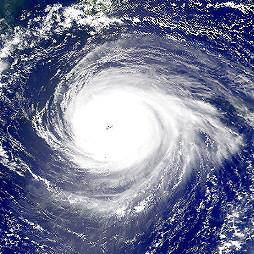Posted 17 February 2013

A storm from space (credit: NASA).
Researchers have found a new technique for generating small-scale climate models from large-scale climate models.
While general models of global circulation are the tool of choice for forecasting the effects of climate change, their spatial resolutions are too broad for the needs of regional planners.
To provide locally-relevant information, modellers typically employ one of two techniques: producing a new forecast using a regional dynamic model, or statistically down-scaling the projections of the larger model.
Jha et al. have proposed a geostatistical technique to translate climate modelling results onto a smaller spatial scale.
This approach geostatistical approach used climate model output from a regional dynamical model for the years 1985 to 2005 to create an image of the Murray-Darling Basin, a 1 million square kilometre watershed in south eastern Australia.
From the model data, the authors identified spatial patterns for three variables: the latent heat flux, soil moisture, and the temperature of the uppermost land surface layer.
The regional model used could produce projections at two different resolutions, with either 50 or 10 square kilometre grid cells.
For the years 1985 to 2005, the authors used model calculations at both resolutions to train their model and learn the relationship between large- and small-scale patterns. For 2006, the authors used their geostatistical technique to statistically downscale the 50 kilometre-resolution model output onto a 10 kilometre grid. They used the 10 kilometre-resolution model output to check their approach.
The authors found that for latent heat flux, surface temperature, and soil moisture, their approach did a good job down-scaling the 50-kilometre model output.
For soil moisture, high resolution artefacts such as rivers and lakes unavoidably impacted the downscaled response.
The authors suggest that although they used a high-resolution regional model to determine spatial patterns, the same could be done using remote sensing techniques.
The technique also has the potential in feature sharpening in remote sensing applications through image fusion, filling gaps in spatial data, and aggregating/disaggregating hydrological and groundwater variables for catchment studies.
Links

Professor Andy Baker features in American Water Resources Association ‘Water Resources Impact’, September 2020 edition.

The Connected Waters Initiative (CWI) is pleased to welcome Taylor Coyne to its network as a postgraduate researcher. If you’re engaged in research at a postgraduate level, and you’re interested in joining the CWI network, get in touch! The CWI network includes multidisciplinary researchers across the Schools of Engineering, Sciences, Humanities and Languages and Law.

The Grand Challenge on Rapid Urbanisation will establish Think Deep Australia, led by Dr Marilu Melo Zurita, to explore how we can use our urban underground spaces for community benefit.

On the 21 August 2020, CWI researchers made a submission to the National Water Reform Inquiry, identifying priority areas and making a number of recommendations as to how to achieve a sustainable groundwater future for Australia.

Results published from a research project between the Land Development Department (LDD) Thailand and UNSW has demonstrated how 2-dimensional mapping can be used to understand soil salinity adjacent to a earthen canal in north east Thailand (Khongnawang et al. 2020).